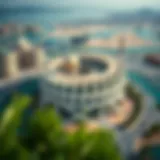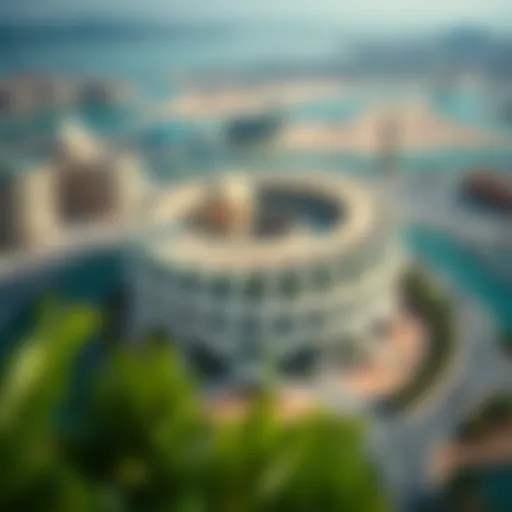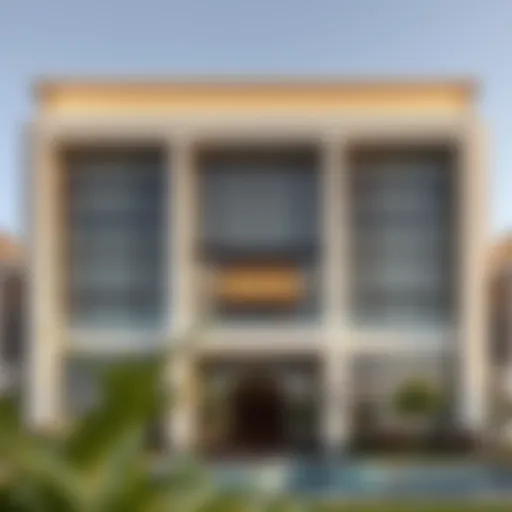Exploring the Impact of Dubai Metro Lines on Urban Life
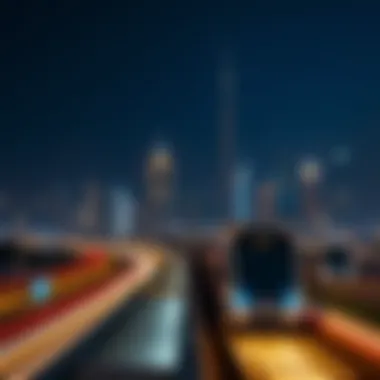

Market Trends and Insights
In the ever-evolving landscape of Dubai's urban environment, the Dubai Metro stands as more than just a transportation system; it is a catalyst for real estate growth and urban development. With its extensive reach and modern infrastructure, the Metro serves as a backbone for mobility, influencing where people choose to live and work. This section explores current trends and forecasts that paint a clearer picture of the future.
Current Trends in Dubai Real Estate
The real estate market in Dubai has witnessed a significant transformation, propelled largely by the convenience provided by the Metro lines. Areas that were once considered suburban are now at the forefront of investment opportunities. Places like Dubai Marina and the City Walk have become even more attractive due to their proximity to Metro stations.
- Increased Demand for Properties Near Metro Stations: Investors and homebuyers are increasingly targeting properties located within walking distance of Metro stops. This trend is heightened by the convenience of using public transport to access key areas like Downtown Dubai, Business Bay, and Dubai International Airport.
- Sustainability and Smart Developments: There’s a growing emphasis on sustainable living and smart technologies in new developments. Builders and architects are taking cues from urban planners to create multifunctional spaces that overlap with Metro lines, promoting an eco-friendly lifestyle.
- Rising Property Prices: As demand grows, so do the prices. Properties situated within the catchment areas of Metro stations have seen steady increases in value, making them favorable for investment. It’s a straightforward equation: the more accessible a location is, the more valuable it becomes.
Predictions for Future Market Developments
Looking ahead, the Dubai real estate market is expected to remain robust, driven by various factors:
- Expansion of the Metro Network: Continued development of the Metro lines means more areas will be connected, thus expanding the boundaries of desirable living. Future extensions, such as the Blue and Green lines, are likely to enhance property values in newly connected suburbs.
- Growth in Population and Tourism: With the anticipated increase in global tourism and expatriate residents, driven by events like Expo 2020, demand for housing will intensify. New regulations and incentives could also encourage more foreign investments.
- Technological Innovations: The smart city initiative in Dubai is set to integrate advanced technologies within the Metro system and surrounding properties. Expect to see innovations related to digital connectivity, which will influence buyer decisions.
"The synergy between the metro system and real estate market can hardly be overstated; each line forged is a pathway to new neighborhoods and opportunities."
In wrapping up our insights into Dubai's market trends, it's clear that the Metro does not merely add convenience but fundamentally shapes urban growth and opportunities for investment. For investors, buyers, and real estate professionals, understanding these trends is key to capitalizing on future opportunities.
Prelims to Dubai Metro
Dubai Metro stands as a vivid representation of modern transport infrastructure, significantly influencing the urban landscape of Dubai. It's not merely a mode of transportation; it embodies the city’s relentless pursuit of efficiency and sophistication. Part of the charm of the metro is its ability to link various districts in this sprawling city. For investors and homebuyers, understanding the nuances of this transportation marvel can shape key decisions about property ventures and living accommodations.
Historical Context
To appreciate the present-day significance of the Dubai Metro, one must consider its historical backdrop. Launched in September 2009, the system was built during a period of rapid urbanization in Dubai. Initially conceived in the early 1990s, the project faced several delays due to economic fluctuations and development priorities. However, with the city's escalating population and mounting traffic issues, the Metro construction gained urgency, culminating in a system that now stretches over 75 kilometers.
In its early days, the Metro operated with just the Red Line, but as demand surged, the Green Line was added, further connecting areas and facilitating better mobility. Over the years, both government and private sectors have recognized the importance of this transport system. This recognition has helped shape policies that encourage urban density near metro stations, ultimately fostering a more interconnected and sustainable city.
Objectives and Vision
The objectives behind the Dubai Metro reflect a grand vision of a smarter, more accessible city. Primarily, it aims to alleviate traffic congestion—not an easy feat in a place known for its booming population and high vehicular use. By offering an efficient alternative to cars, the Metro promotes a significant reduction in road congestion, resulting in lower carbon emissions and more pedestrian-friendly urban spaces.
Moreover, the vision extends beyond mere transport efficiency. There’s an underlying commitment to redefine how residents experience mobility. As such, the Metro aims to integrate seamlessly with other forms of transportation, creating a comprehensive transportation network.
Investors and realtors should take note—properties within close proximity to metro stations tend to appreciate faster. This reflects both the convenience offered to residents and the overall desirability of living in a well-connected city. Thus, the objectives and realities of the Dubai Metro should be a fundamental consideration for anyone looking at real estate prospects in this dynamic urban environment.
Overview of Metro Lines
The Dubai Metro is not just another mode of transportation; it serves as a key artery in the urban fabric of the city. Understanding the metro lines is crucial for grasping how they facilitate not only day-to-day commuting but also the larger context of urban development and real estate dynamics.
Both the Red Line and Green Line offer unique routes that cater to various aspects of city life. They connect residential areas, business districts, educational institutions, and leisure facilities, showcasing the metro's role as a backbone for public transit. The efficient design of these lines ensures that they contribute to reduced traffic congestion, encouraging residents to leave their cars behind and rely on alternative transportation. This shift is particularly significant in a city like Dubai, where the population is rapidly expanding and urban sprawl is a constant challenge.
Beyond convenience, the metro lines impact property values significantly. Locations near stations often see a rise in real estate demand, making them highly sought after by investors and homebuyers alike. The metro's accessibility can enhance neighborhood appeal, leading to long-term growth opportunities.
In summary, a deep dive into the Dubai Metro lines reveals not just their operational characteristics but also their implications for urban mobility and real estate. This overview sets the stage for an in-depth examination of the Red and Green lines, highlighting the distinct contributions of each to the city's transportation framework.
Red Line
Route Highlights
The Red Line runs from Rashidiya to UAE Exchange, spanning 52.1 kilometers. It is well-known for its strategic layout that connects crucial areas like Al Rigga, Burj Khalifa, and Mall of the Emirates. This route enables metro users to hit major attractions without the usual traffic woes. The incorporation of stops near landmarks is a big feature, drawing in both residents and tourists.
One standout element is the seamless travel experience offered along the line. With consistent frequency and connectivity, riders find this line to be reliable and efficient. Additionally, its above-ground sections afford passengers scenic views of Dubai’s skyline, contributing to an overall enjoyable journey.
Key Stations
Key stations along the Red Line, such as Burj Khalifa/Dubai Mall and Dubai Marina, provide not just access but also a comprehensive travel experience. Each station is equipped with modern amenities, ensuring comfort for all passengers. The iconic role of these stations goes beyond being transit points; they are gateways to some of Dubai's major attractions and business hubs.
Moreover, the design of these stations incorporates both aesthetic elegance and functionality, making them distinctively appealing. This dual focus, on experience and utility, adds to the attractiveness for both commuters and potential investors looking at businesses located nearby.
Connections to Other Transport Modes
One of the Red Line's strong suits is its integration with various transport modes. Passengers can transfer easily to the bus and taxi networks, making for a convenient commuting experience. The Metro also connects with the Dubai Tram, augmenting the public transport tapestry in the city.
This connectivity is vital in a bustling metropolis where the efficiency of transportation can make or break daily plans. The strategic placement of interchange stations boosts overall mobility, encouraging more people to opt for public transport. Such an interconnected system also minimizes travel times, further solidifying the metro's role as a primary means of urban transport.
Green Line
Route Highlights
The Green Line, stretching from Etisalat to Dubai Creek, encompasses key districts like Deira and Bur Dubai. This line offers a unique perspective of the city's cultural mélange, serving places influenced by the city's rich heritage. It covers areas often missed by the more commercial Red Line, making it an important transit route for those living in older neighborhoods.
Both residents and explorers appreciate its accessibility to local markets and traditional attractions. The Green Line's capacity to provide both practicality and local flavor makes it a treasured part of the metro system.
Key Stations
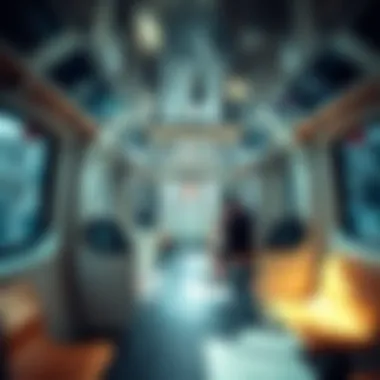

Highlighted stations such as Al Fahidi and Baniyas Square are central to understanding the Green Line's significance. These stations predominantly serve communities rich in history and local culture, providing access to art galleries, museums, and historical sites.
Investors eye these areas due to their potential for development and appreciation in property values over time. The neighborhood feel in these districts presents unique opportunities for businesses that cater to both locals and tourists, further driving economic growth in the region.
Interchange Stations
The Green Line’s interchange stations add another layer of accessibility, particularly at locations like Union and Bur Juman. This strategic advantage enhances commuter flow between multiple lines, ensuring that passengers have smoother transitions and shorter travel times.
The efficiency with which these interchange stations operate contributes to the overall appeal of the metro system. They reduce the likelihood of congestion at major hubs and make travel across the city more manageable, catering to a diverse demographic ranging from daily commuters to occasional travelers.
Understanding these metro lines and their features sheds light on the broader implications for urban planning, mobility, and real estate in Dubai. The efficient interconnectivity ensures that the metro system remains a pivotal asset for both current residents and future developments.
Impact on Urban Mobility
The Dubai Metro line still represents one of the city’s most ambitious moves towards an integrated transportation system. When it comes to urban mobility, the implications of having a robust metro system extend far beyond just moving people from point A to point B. It’s a fundamental change in how residents and visitors experience the city.
One of the primary advantages of an efficient metro system is the drastic reduction in traffic congestion. Consider this: many people in Dubai rely on personal vehicles which contributes to not only daily traffic jams but also increases pollution levels. The Dubai Metro stimulates an alternative to this car-centric infrastructure. With the metro, commuters can hop on and off at various points without the headaches of driving through traffic. This reduction in vehicles on the road contributes to smoother overall transit in the urban landscape.
Increasing traffic volumes necessitate innovative solutions. Beyond just alleviating congestion, the metro fosters an environment where public transit becomes a practical and attractive option. As ridership increases, it creates a cycle—more riders encourage frequent service improvements. People begin to favor the metro not just for commute but as a part of their day-to-day life.
Another crucial aspect is public access. The UAE’s diverse demographic boasts a mix of residents, workers, and tourists, all needing effective methods of transportation. The metro’s reach has allowed access to a variety of essential services, from education to healthcare and entertainment. For instance, educational institutions situated near metro stations enjoy increased student foot traffic, consequently boosting enrollment.
While the boost in public mobility is substantial, it influences urban planning and real estate development significantly. Areas around metro stations often experience a surge in property values. As demand for residential and commercial property grows in these locales, investors find more interest in developments around metro lines—making it a lucrative opportunity for realtors and developers alike.
Bringing all of this together, the metro serves not only as a transportation tool but as a catalyzer for urban transformation. Cities that effectively utilize metro systems often experience an enhancement in overall livability—providing an efficient, wise, and structured approach to urban transit.
"Public transport is not just a means of moving people; it is a key to comprehensive urban planning—carving the way for greener cities."
In summary, the introduction and enhancement of the Dubai Metro is a game-changer in urban mobility. The tangible benefits extend from reducing congestion to facilitating greater public access, demonstrating the multifaceted role that transportation systems play in shaping the urban environment.
Metro Line Features
The features of the Dubai Metro lines are central to understanding how this modern transportation system has shaped urban mobility in the Emirate. These features reflect a conscientious design aimed at enhancing accessibility, efficiency, and user experience. They contribute significantly to the overall goals of the metro system, aligning with Dubai’s vision of facilitating easy movement across the city. The impact of such features extends beyond mere transport; they play a pivotal role in influencing urban architecture, economic activities, and the daily lives of residents and visitors alike.
Stations and Infrastructure
Dubai Metro's station design and surrounding infrastructure are crafted with a blend of functionality and aesthetics. The metro currently boasts 49 stations, ensuring extensive coverage that reaches key districts. Stations such as the Burj Khalifa/Dubai Mall and Dubai Marina highlight the commitment to integrating transport hubs within vibrant urban centers.
- Architectural Design
- Safety and Security
- Transit Accessibility
- The stations feature a modern, sleek design with glass and steel structures, making them not just transit points but architectural landmarks in their own right.
- Each station is equipped with amenities like waiting areas, retail options, and accessible facilities for those with disabilities.
- Comprehensive safety measures including surveillance systems and emergency protocols ensure a secure environment for all passengers.
- Fire safety systems and regular training for staff contribute to maintaining high safety standards.
- Optimal placement of stations near residential and commercial areas encourages metro usage over private vehicles, alleviating congestion on roads.
The infrastructure integrates seamlessly with the broader transport network, creating opportunities for better urban planning and development around these transit nodes.
Technology Integration
Technology is at the heart of the Dubai Metro's operational efficiency. The integration of advanced systems enhances reliability and convenience, crucial for a fast-paced city like Dubai.
Automated Train Operation
Automated Train Operation (ATO) is a defining feature of the Dubai Metro. This system allows trains to operate with minimal human intervention, significantly improving punctuality and safety.
- Key Characteristic
- Benefits for Commuters
- Unique Features
- ATO systems utilize sophisticated control algorithms and sensors that enable continuous monitoring and adjustments, ensuring trains maintain optimal speed and spacing.
- The use of ATO minimizes delays, providing a more reliable service. Commuters can depend on trains arriving at regular intervals, which reduces waiting times.
- Furthermore, ATO allows for the management of train flows in crowded situations, adapting to real-time conditions without requiring manual interference.
Though successful, there are challenges regarding maintenance and potential system failures that could impact service continuity. However, the benefits often outweigh the risks, solidifying ATO as a vital asset for Dubai’s rapidly growing transit needs.
Ticketing Systems
The ticketing systems employed are designed to enhance the user experience while ensuring operational efficiency. These systems leverage technology to streamline the ticketing process.
- Key Characteristic
- Benefits of the System
- Unique Feature
- The Nol card system, for example, enables commuters to tap their cards for entry and exit, facilitating a smooth and quick boarding process.
- This technology reduces the need for cash transactions and minimizes queue times at ticket machines. Commuters appreciate the ease and speed of using these smart cards.
- Furthermore, these cards can be used across various modes of transport, including buses and water taxis, reinforcing the seamless transit experience for users.
However, reliance on technology may present disadvantages such as system outages impacting card usage and potential technical malfunctions. During peak hours, the demand may also lead to congested entry points that occasionally disrupt the flow of passengers.
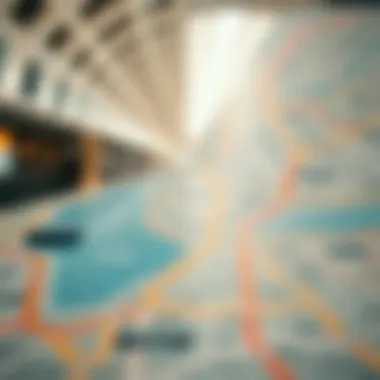

Overall, the features of the Dubai Metro lines not only facilitate valuable transport options but also act as catalysts for urban transformation, boosting both residential and commercial value in adjacent areas. Investors and potential homebuyers should recognize the significant advantages offered by these metro line features.
Real Estate Influences
The relationship between the Dubai Metro and real estate is both intricate and pivotal. As the metro lines extend across the city, they bring about significant changes not only in urban mobility but also in property values and desirability. The influence of the metro on real estate trends is notable and merits a comprehensive examination.
Metro Proximity and Property Value
Living near a metro station can have profound effects on property value. The basic concept is simple: convenience attracts buyers and tenants. Properties located within close proximity to metro stations generally command higher prices due to their accessibility. In Dubai, this has been particularly evident in areas such as Dubai Marina and Downtown Dubai. A study from the Dubai Land Department indicated that properties within a half-mile radius of metro stations experienced an appreciation in value by nearly 15% over five years, compared to those located farther away.
Factors influencing this increase include:
- Accessibility: Short commutes reduce travel time, making these neighborhoods attractive for professionals and families.
- Transport Connectivity: Direct connections to key areas like the Dubai Mall or business districts heighten a property's appeal.
- Amenity Availability: Proximity to restaurants, shops, and parks generally enhances desirability.
Developments Around Stations
The development around metro stations reveals how urban expansion is closely tied to transport infrastructure. Developments close to stations not only attract potential homeowners but also businesses looking to capitalize on foot traffic. Developers often seek to erect mixed-use buildings, combining residential, commercial, and leisure spaces. This blend creates vibrant neighborhoods that support a healthy lifestyle.
Examples of recent projects include:
- City Walk: A bustling mix of retail, dining, and residential options, designed to appeal to both locals and tourists alike.
- Dubai Design District: A hub for creatives and designers, this area is becoming increasingly popular due to its connectedness.
Moreover, local government often incentivizes developments near metro stations through favorable zoning laws and construction permits. Leading to dynamic urban landscapes that evolve alongside the city's transport network.
"Investors are increasingly looking at transport links, like metro stations, as a means for assessing property value. The Dubai Metro significantly shapes the market."
As a result, understanding these influences is crucial for investors, homebuyers, and urban planners alike. The correlation between the Dubai Metro and real estate isn't merely academic; it affects decisions daily.
Recognizing these factors can aid in making informed choices, aligning investments with projected urban growth, and maximizing returns. Future expansions will likely open new opportunities in areas not yet connected, making early investment in these regions potentially lucrative.
Future Expansions and Projects
The Dubai Metro is not just a marvel of engineering; it is a living entity, continuously evolving to meet the demands of a fast-paced metropolis. Future expansions and projects are crucial because they reflect not only the city's ambition but also its commitment to sustainability and efficient urban mobility. Incorporating new routes and technologies aligns with global trends in public transport, thus enhancing connectivity and accessibility for residents and visitors alike.
Upcoming Metro Lines
Planned Routes
The planned routes for the Dubai Metro are quite exciting and pivotal for the future of urban transport in the emirate. New lines, such as the Purple Line and the Blue Line, are designed to cater to areas that are experiencing rapid growth. For instance, the Purple Line will connect to pivotal locations like the Dubai International Airport and key financial districts, giving commuters a seamless travel experience.
- Key Characteristics: One standout feature of these planned routes is the incorporation of eco-friendly technologies that reduce emissions. This aspect aligns with Dubai's goals of being a sustainable city.
- Benefits: By strategically locating stations near significant developments, such as the Dubai World Central, these new routes are expected to boost real estate values in adjacent areas, making them attractive for investors and homebuyers.
The benefits of the planned routes are manifold, extending beyond mere transportation. They are intended to strengthen social integration by allowing communities that were once isolated to connect. However, the challenge lies in the extensive planning and investment required for such ambitious projects:
- Advantages: Longer track lengths mean more accessibility for residents and tourists.
- Disadvantages: There is also the potential for construction delays which may disrupt current transport services.
Projected Timelines
The projected timelines for the new metro lines are ambitious but achievable, and they serve a critical function in ensuring that investors and residents can plan ahead. Currently, projections suggest that construction for the next phases is set to commence within the next year, with operation expected by 2027.
- Key Characteristic: One notable aspect of these timelines is the emphasis on rapid deployment. Using modular construction techniques allows completion within shorter timeframes, which means residents can benefit from new services sooner.
- Benefits: Investors and developers can start imagining future prospects as these timelines encourage planned growth in tandem with transit development.
Nevertheless, it’s essential to keep in mind that:
- Advantages: Rigid adherence to these schedules could mean quicker returns on investment in surrounding properties.
- Disadvantages: Fluctuations in market conditions can delay progress, making timelines subject to changes.
Integration with Other Transport Modes
Successful integration with other transport modes is fundamental for the seamless operation of the metro system. There are already ongoing discussions about connecting the metro to bus stations, trams, and even water taxis. This holistic view of transport infrastructure ensures that mobility in Dubai doesn’t just rely on one mode of transport but rather creates a unified system that benefits everyone, particularly expats and tourists.
"Effective integration signifies not only a commitment to infrastructure but also a vision for a future where mobility is smooth and efficient."
It is also anticipated that the metro will connect with global transport systems, allowing for greater accessibility for international travelers:
- Examples: Direct lines from the metro to the airport or designated business hubs can significantly improve the ease of travel.
- Strategic Importance: Such measures can also encourage tourists to use public transport, easing congestion on the roads and promoting an environmentally friendly travel ethos.
Challenges Facing the Metro System
When discussing the Dubai Metro, it's essential to shine a light on the hurdles that this impressive infrastructure faces. While the metro plays a crucial role in urban mobility and the overall development strategy of Dubai, it's not without its share of challenges. Understanding these limitations helps stakeholders—from investors to residents—appreciate both the benefits and the considerations necessary for its well-being and future development. Without addressing these challenges head-on, the very effectiveness of the metro is at risk, potentially impacting local economies and property values.
Operational Limitations
The operational limitations of the Dubai Metro are multifaceted, often stemming from the rapid pace at which the metro was built compared to the increasing demands of a booming population. One major concern is the frequency of train service, especially during peak hours. Commuters may find themselves sandwiched in crowded cars, leading to an unpleasant travel experience. To combat this, RTA (Roads and Transport Authority) regularly assesses train schedules and may implement adjustments to improve efficiency.
Moreover, the limited coverage area can also hinder accessibility for residents in certain districts. Although the current lines are strategically planned, there remain pockets of the city that lack direct metro access. This issue can complicate travel, forcing some to rely on alternative transport modes, like taxis or buses, which may not provide the same level of convenience.
Continuing expansion plans aim to address these shortcomings, but operational challenges remain while easing congestion and ensuring seamless transitions between different lines. Key considerations must include but are not limited to:
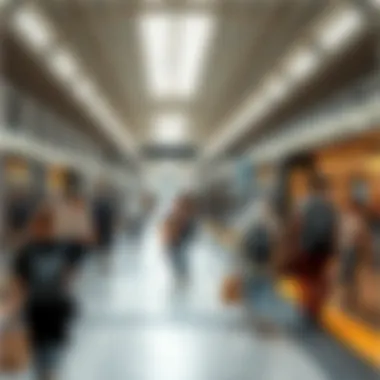

- Adapting to passenger growth: Accurate forecasting of ridership trends is vital.
- Cross-line connectivity: Enhancements in interchange points can significantly ease travel pains.
- Safety measures: Ensuring safety protocols are rigorously followed is non-negotiable, especially in crowded commuter times.
Maintenance and Upkeep
The importance of maintenance and upkeep in the metro system cannot be overstated. Just as an automobile requires regular service to ensure optimal function, so does the urban rail system. The Dubai Metro utilizes cutting-edge technology, which requires consistent maintenance to keep operations efficient and safe. However, this can sometimes be a financial burden, possessing its own set of limitations. Ensuring that all systems run smoothly means allocating resources towards not just routine checks, but unexpected repairs as well.
One area that stands out is the necessity for maintenance of the sophisticated signaling systems that control train movements. Delays due to malfunctions can ripple through the entire network—affecting schedules, causing passenger frustration, and perhaps diminishing overall ridership as people may explore alternative routes.
Additionally, the upkeep of the stations themselves is paramount. The stations are the face of the metro system, and they must remain not only functional but also aesthetically pleasing. Regular cleaning, upgrades, and unexpected repairs affect not only user experience but also public perception of the metro's reliability.
Key aspects that deserve continuous focus include:
- Routine inspections: Timely evaluations of trains and infrastructure are vital.
- Stakeholder collaboration: Effective communication between maintenance crews and operational teams can prevent issues before they escalate.
- Budget allocation: Balancing maintenance costs against operational budgets to ensure sustainability is critical.
"The smoother the ride, the more effortless the journey; but a bumpy road can lead to unexpected detours."
The challenges facing the Dubai Metro system are complex, and addressing them requires ongoing commitment and collaboration among all stakeholders. By zoning in on operational limitations and ensuring rigorous maintenance efforts, Dubai can continue to solidify its metro system as a pillar of urban mobility.
Sustainability Initiatives
The sustainability initiatives behind the Dubai Metro are more than a buzzword; they're a critical aspect of the city's transportation planning, aligning with global trends towards eco-consciousness. In a metropolis like Dubai, which is synonymous with luxury and high living standards, it's important for public transport systems to embody these values while remaining environmentally sustainable.
Efforts to integrate eco-friendly solutions into the Metro’s operation not only serve to reduce the ecological footprint but also resonate strongly with the values of a growing population of socially-responsible investors and residents.
Energy Efficiency Measures
Energy efficiency measures have become a cornerstone of Dubai Metro operations. One of the standout contributions is the electrification of the trains, which enables improved energy management compared to traditional diesel solutions.
Moreover, the innovative use of regenerative braking technology plays a pivotal role here. When trains brake, the energy generated is not wasted but fed back into the system, significantly reducing energy consumption.
This commitment to efficiency translates into substantial cost reductions, both for operational budgets and for fare prices overseen by the Roads and Transport Authority (RTA).
Another notable approach is the installation of energy-efficient LED lighting throughout stations and tunnels, which can reduce energy use by up to 50%. Such initiatives not only help to lower operational costs but also create a more inviting atmosphere for passengers.
Green Certification Efforts
Achieving green certification is more than just a goal; it’s an integral part of ensuring Dubai Metro aligns with global sustainability standards. The Metro's stations and facilities are undergoing assessments to meet criteria set by internationally recognized green building certifiers.
The emphasis on sustainable architecture and operational practices might include using recycled materials for construction, optimizing water usage with low-flow fixtures, and ensuring that waste management systems effectively divert recyclable materials from landfills.
In particular, the certification process involves rigorous audits and measures that focus on various aspects like energy usage, water efficiency, and the overall carbon footprint. Not only does this enhance the environmental standing of the Metro, but it also signals to investors that Dubai is serious about creating sustainable urban environments.
"Sustainability in public transport is not just an addition to existing operations; it's a fundamental rethink of how we build and maintain our infrastructure."
By integrating these sustainability initiatives, the Dubai Metro sets itself apart not only as a transit system but as a vital part of the city’s broader ecological strategy, appealing to those who prioritize investment in responsible and forward-thinking infrastructure. Overall, these measures and certifications contribute to a livable city that balances luxury with ecological responsibility.
Comparative Analysis
In the realm of urban transport systems, conducting a comparative analysis serves as a crucial tool for understanding not just the successes of a specific system like the Dubai Metro, but also the challenges and lessons gleaned from different cities around the globe. Such an analysis allows investors, homebuyers, realtors, and urban planners to grasp the dynamics of metro systems and their broader implications on urban mobility and real estate development.
Comparative analysis doesn’t merely put systems side by side; it delves into the nuts and bolts of operation, efficiency, user experience, and even funding mechanisms. By drawing parallels, one can understand what worked well in one context may falter in another. It’s essential to weigh performance metrics, like punctuality, ridership, and construction costs, against the backdrop of local geographical, social, and economic factors.
Global Metro Systems
When examining global metro systems, an array of examples exist that illustrate diverse approaches to public transport. Consider the New York City Subway, a venerable system that has laid down tracks since 1904. Known for its extensive reach but plagued by congestion and aging infrastructure, it serves as a case study in balancing historical significance with modern demands.
On the other hand, take a look at the systems in cities like Tokyo. The Tokyo Metro is hailed for its punctuality and efficiency, seamlessly integrating various modes of transport. It showcases how advanced technology and precise operational planning can contribute to a user-focused experience. Both globally renowned systems reveal how diverse methodologies can address similar urban transport challenges, giving insights valuable to Dubai Metro's ongoing developments.
Lessons from Other Cities
Learning from the successes and pitfalls of other cities highlights patterns that could either inspire the enhancements of the Dubai Metro or serve as cautionary tales. For example, the London Underground, with its rich history, has faced various hurdles including extensive maintenance issues, underscoring the importance of regular infrastructure upkeep. Investing in preventive maintenance not only extends the life of infrastructure but also ensures safety and service reliability.
Conversely, cities like Singapore have pioneered innovations in integrating their metro systems with urban functionalities, where stations double as hubs for commercial activity. This dual purpose serves to enhance foot traffic and, consequently, local economies.
In urban transport planning, success lies not just in execution but in the ability to learn from others while adapting to local contexts.
By understanding these dynamics, stakeholders can make informed decisions that align with both their immediate needs and long-term goals.
End
In summing up the intricacies of the Dubai Metro system, it becomes undeniably clear that this mode of transportation is far more than just tracks and trains. It serves as a backbone for urban mobility and is at the heart of the geographic and demographic evolution of Dubai. The insights gathered throughout this exploration highlight how the metro lines have redefined travel within the city and supported broader objectives in urban planning and infrastructure.
Recap of Key Insights
- Catalyst for Urban Growth: The metro's influence on easing traffic congestion cannot be overstated. By offering an efficient alternative to road travel, it directly enhances daily commutes for residents and workers alike, making the city seamlessly navigable.
- Real Estate Dynamics: Proximity to metro stations often translates to enhanced property values, thus attracting investors and homebuyers interested in long-term gains. Areas within reach of the metro tend to flourish, prompting new developments that further enrich the urban fabric of Dubai.
- Technological Integration: The innovative technology employed in the operations of the metro, from automated train systems to advanced ticketing solutions, showcases Dubai’s commitment to remaining at the forefront of global transportation trends. Such features not only optimize operational efficiency but also enhance the rider experience.
“The Dubai Metro is a blueprint for future urban transport systems globally. Its blend of accessibility, efficiency, and sustainability is something other cities aspire to replicate.”
Looking Ahead
As we glance towards the future, the trajectory of the Dubai Metro appears promising, with several expansions and improvements in the pipeline. The planned extensions are designed not merely to increase reach but to also interlink various transport modes, making it easier for individuals to transition from metro to bus or taxi services without hassle. Key considerations include:
- Future Lines Expansion: Projects are underway to create new routes, including those reaching outer suburbs, thus ensuring more residents benefit from this essential service.
- Enhanced Integration: Future strategies will focus on seamless connectivity with other transport frameworks, ensuring that the metro continues to be a pivotal part of Dubai's transport ecosystem.
- Sustainability Goals: There is a concerted effort to maintain energy-efficient practices, aligning with Dubai’s long-term sustainability objectives.
The ongoing evolution of the Dubai Metro is an insightful case study for urban planners and policymakers globally. It emphasizes not only the necessity for efficient transport systems but also their significant role in shaping urban livelihoods and enhancing the quality of life in bustling metropolises.


